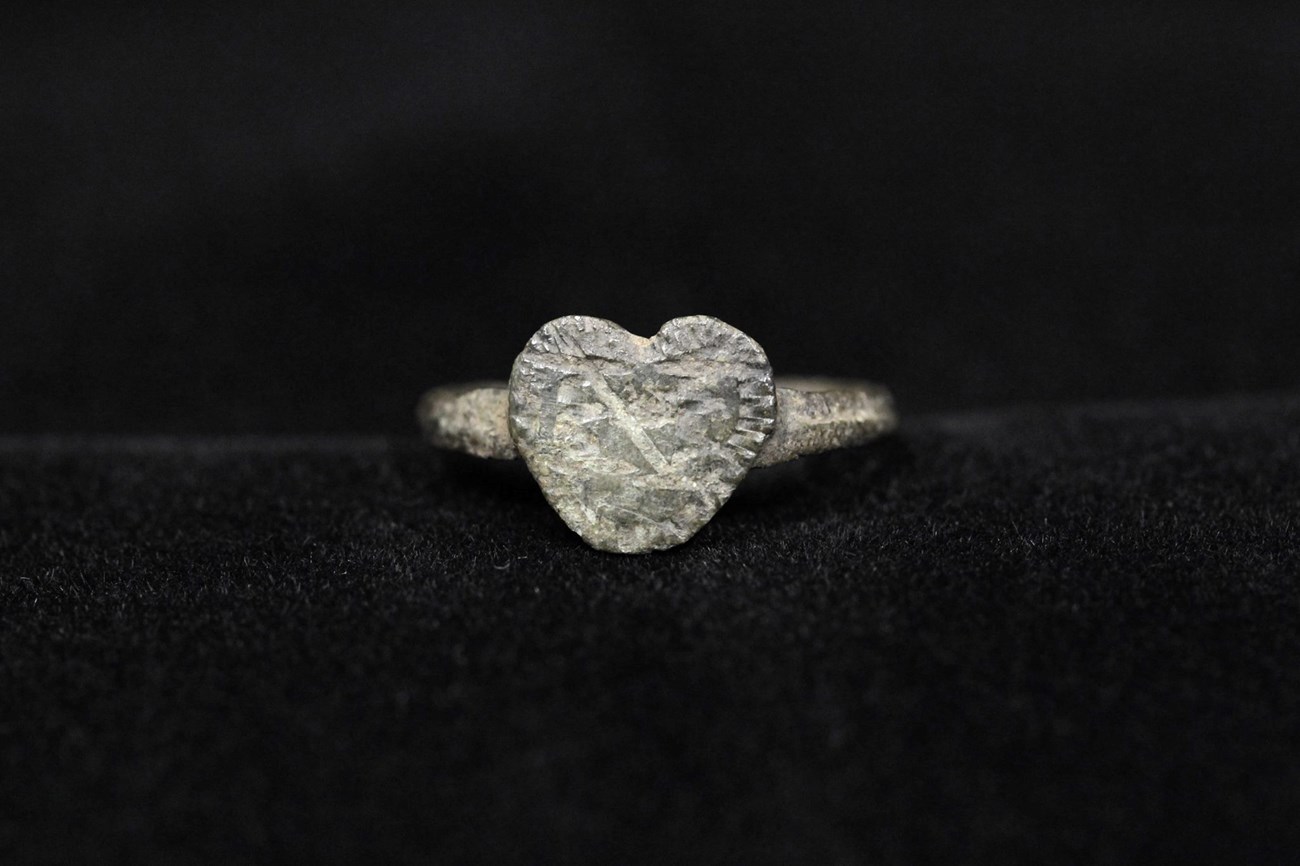Part of a series of articles titled Curious Collections of Fort Stanwix, The Oneida Carry Era.
Previous: Archaic Lamoka Projectile Point
Next: Roseboom Ledgers
Article

National Park Service
Within the park collections lies a heart-shaped metal ring, found during archeological excavations. Similar looking rings of brass, pewter, copper, and other metals have been found across the Great Lakes at sites affiliated with fur trade between Europeans and natives. They commonly have a small plaque (in various shapes) on a band in and have different etchings, initials, and simple designs on them. Sites they’ve been found at include Fort Michilimackinac and Detroit, MI and Rock Island, WI. But they have been also found as far away as western Missouri.
These rings were used for both religious and secular trade purposes. An example of religious use comes from Oneida missionary Father Jaques Bruyas, who in about 1670 stated that “if his pupils could repeat on Sunday what he had taught during the week, they were rewarded by a gift of beads or brass rings.” The biggest example of trade use comes from a cache of hundreds of rings found off the coast of Texas in a shipwreck belonging to French explorer René-Robert Cavelier, Sieur de La Salle. They have been found in many other secular contexts that show that the items themselves (if not the symbology behind them) were considered popular personal decorations.
The Jesuits (or Society of Jesus) were a Catholic order founded by St. Ignatius of Loyola in 1540. By their founder’s death in 1556, about 1,000 Jesuits were already working throughout Europe and in Asia, Africa, and the New World. By 1626 the number of Jesuits was 15,544, and in 1749 the total was 22,589. At one point in history, they were one of the most powerful religious orders in Catholicism. But by the mid-1700s, due to a variety of reasons, had been outlawed or expelled from most Western European societies. The remain in existence today, however in a diminished capacity when considering the height of their power in the 1500s and 1600s.
The best-known Jesuit missionary in the New York area was French Priest Simon Le Moyne. Between 1652 and 1654 he made six journeys into Onondaga territory offering peace and Christianity on behalf of New France (Canada). By late 1655, Le Moyne oversaw the consecration of Sainte-Marie-de-Ganentaa (or Ste. Marie among the Iroquois), the only Catholic church in Haudenosaunee territory to offer all of the most significant sacraments of the Catholic faith. The Jesuit goal was to convert the Five Nations to Christianity, and potentially make them allies of the French; like they had the Huron, prior. The Huron were a rival tribe to the Haudenosaunee, who lived in the Great Lakes region and allied themselves with the French.
Over the next three years, multiple Jesuit priests were allowed to move into the primary villages of the Haudenosaunee; including near Oneida Castle, the Kahnawá:ke Mohawk, and an unnamed Cayuga village. Responses were varied. Some were taken prisoner after a short time; some established large parishes and were able to obtain converts. Most of these converts came from Mohawk communities. Sainte-Marie-de-Ganentaa also served as a base for the Jesuits to travel to Fort Orange (modern Albany, NY) and attempt to convert the Dutch Protestant population there.
Finally in 1658, only six short years after Le Moyne's mission began, Sainte-Marie-de-Ganentaa was abandoned after threats were made by Mohawks. Reasoning over why becomes unclear in Jesuit records. They blame a combination of Dutch influence, poorly guided Mohawks for not seeing reason, and Onondagas for not seeing a supply party through to the mission as Mohawks threatened war against Montreal. More likely it was a response to changing dynamics in the Five Nations’ communities as more converts retreated to Canada with missionaries and left their tribesmen in an unbalanced war against the Huron Indians, who too, had made peace with the French and began to convert to Catholicism. This threat to the mission base in the heart of their territory was probably a warning. Some missionary priests however (like Fathers Bruyas and Pierre Millet in Oneida territory), were asked to or allowed to stay elsewhere.
It is unknown how this ring came to be at Fort Stanwix. Was it dropped by a Jesuit or a native convert on one of their many trips across the area of the Oneida Carry? Was it a trade item passed down to a future resident of the fort? Or was it lost from a 19th Century home after many years in a personal collection? How do you think it ended up here?

Part of a series of articles titled Curious Collections of Fort Stanwix, The Oneida Carry Era.
Previous: Archaic Lamoka Projectile Point
Next: Roseboom Ledgers
Last updated: February 9, 2023